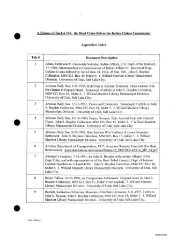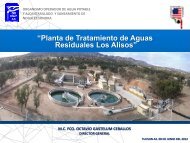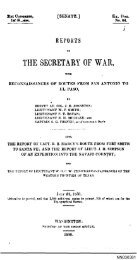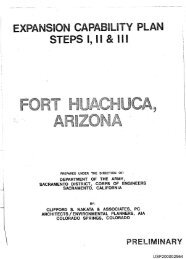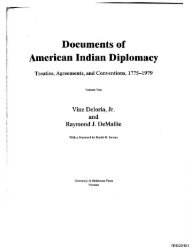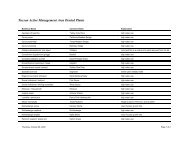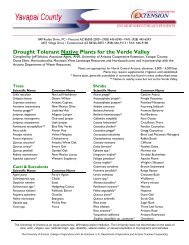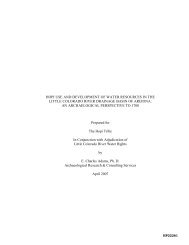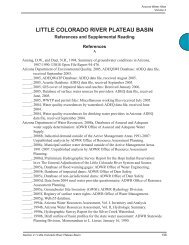PEACH SPRINGS BASIN
PEACH SPRINGS BASIN
PEACH SPRINGS BASIN
Create successful ePaper yourself
Turn your PDF publications into a flip-book with our unique Google optimized e-Paper software.
<strong>PEACH</strong> <strong>SPRINGS</strong> <strong>BASIN</strong><br />
The Peach Springs basin, located in northwestern Arizona, contains approximately 1,400<br />
square miles (Figure 13). The basin is bounded on the west by the Grand Wash Cliffs and<br />
Music Mountains, on the north by the Colorado River, and on the east by the Aubrey Cliffs.<br />
The western part of the basin is made up of the Hualapai Plateau, composed of flat-lying<br />
interbedded limestones, shale, and sandstones. Aubrey and Truxton Valleys are east and<br />
south of the Hualapai Plateau respectively, and are major drainages that are filled with<br />
recent lava flows and alluvial sands, silts, and gravels.<br />
Elevations in Peach Springs basin vary from 1,000 feet above mean sea level, where<br />
Quartermaster Canyon meets the Colorado River, to 6,800 feet above mean sea level in<br />
the Music Mountains. Elevations on the Hualapai Plateau are 4,000 to 6,000 feet above<br />
mean sea level.<br />
1<br />
SECURING ARIZONA’S WATER FUTURE<br />
There are no perennial streams in the Peach Springs basin and groundwater is the only reliable source of water supply.<br />
Truxton Wash drains runoff from the Truxton Valley area into the Hualapai Valley and eventually into the Red Lake Playa.<br />
Numerous ephemeral washes on the Hualapai Plateau drain water to the northeast and into the Colorado River. Several<br />
of the larger washes on the plateau follow major faults.<br />
The Peach Springs basin can be divided into two separate geomorphic areas, an upland area comprising the Hualapai<br />
Plateau, and a lowland area consisting of Truxton and Aubrey Valleys. Each of these areas has its own distinct geology<br />
and hydrologic characteristics.<br />
The Hualapai Plateau is made up of interbedded limestones, shales, and sandstones that dip gently to the northeast. The<br />
main water- bearing unit on the Plateau is the Muav Limestone. Groundwater moves downward and northeast along<br />
fractures and bedding planes in the sedimentary rocks. The groundwater is eventually trapped in fractures and solution<br />
channels in the Muav Limestone by the underlying Bright Angel Shale. The water then exits the basin by numerous<br />
springs that issue from the Muav Limestone in the Grand Canyon. Hutoon (1977) estimated annual spring flow from the<br />
Plateau to be approximately 2,900 acre-feet of water.<br />
Water levels on the Hualapai Plateau vary from 100 feet below land surface near Peach Springs to over 1,300 feet below<br />
land surface in the central basin area (Myers, 1987). Well yields from the Muav Limestone are variable depending on the<br />
degree of fracturing in the limestone. Representative well yields are from 5 to 40 gallons per minute, with 146 gallons per<br />
minute the highest reported (Twenter, 1962; Myers, 1987). The rest of the Paleozoic rocks are dry, except where local<br />
structural or stratigraphic conditions may trap small amounts of water.<br />
In addition to the Muav Limestone, groundwater also occurs in Tertiary-Quaternary sedimentary deposits. In the northern<br />
Aubrey Valley around Frazier Wells, water is found in gravel beds. Depth to water generally is shallow, 12 to 100 feet<br />
below surface level, and well yields of 10 to 30 gallons per minute have been reported (Myers, 1987). In the Truxton<br />
Valley area, lake-bed deposits are a locally-dependable source of groundwater. Small domestic and stock wells yield up to<br />
10 gallons per minute (Myers, 1987). Depth to water ranges from 125 to 535 feet below surface level in the Truxton area<br />
(Myers, 1987).<br />
The Precambrian rocks, isolated volcanic, and local alluvial sands in washes can provide minor amounts of water to local<br />
low-yield wells in some areas of the basin; however, the ability of these aquifers to provide water is extremely variable<br />
and dependent on local geologic conditions. The amount of groundwater available in the Peach Springs basin is unknown.<br />
Groundwater on the Hualapai Plateau generally is deep, and the saturated thickness of the limestone aquifer is difficult to<br />
determine. In Aubrey and Truxton Valleys, water is limited to a few permeable layers in the sequence of basin-fill<br />
deposits. The U.S. Geological Survey has estimated that there are approximately 1,000,000 acre-feet of recoverable water
2<br />
SECURING ARIZONA’S WATER FUTURE<br />
to 1,200 feet in the Truxton Valley area (Freethey and Anderson, 1986). No estimate is available for the amount of water<br />
in Aubrey Valley, however, there is probably a similar amount in storage in the valley's aquifers.<br />
Because population is sparse, groundwater development in the basin is slight. The U.S. Geological Survey (1986)<br />
estimates that pumpage from the basin is less than 500 acre-feet per year. Only one well with historic water levels occurs<br />
in the basin; therefore, any water-level changes that may have occurred in the basin have not been recorded. Water<br />
quality in most wells in the basin generally is good. Total dissolved solids and fluoride levels are below maximum<br />
contaminant levels in most wells tested (Myers, 1987).



